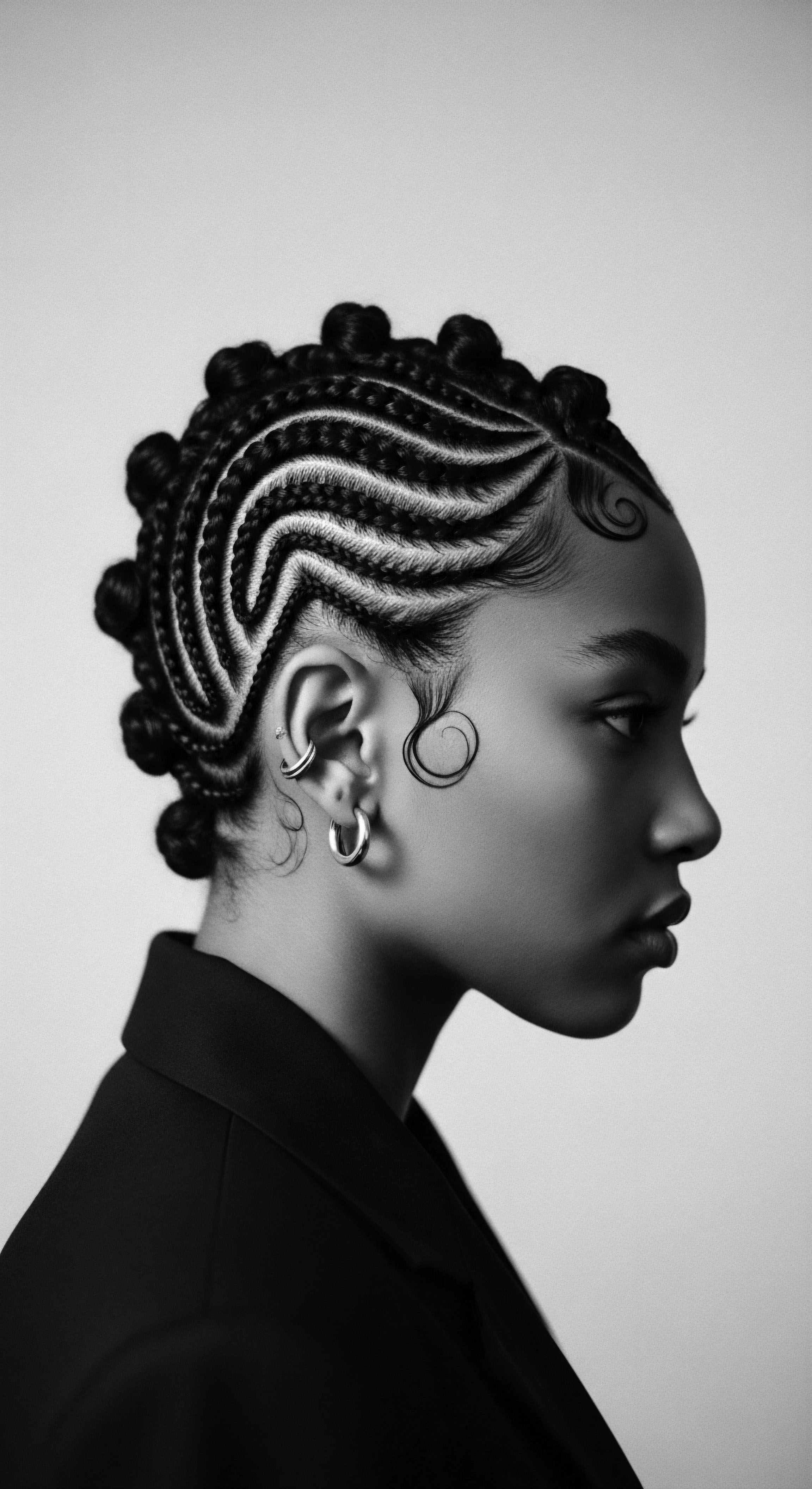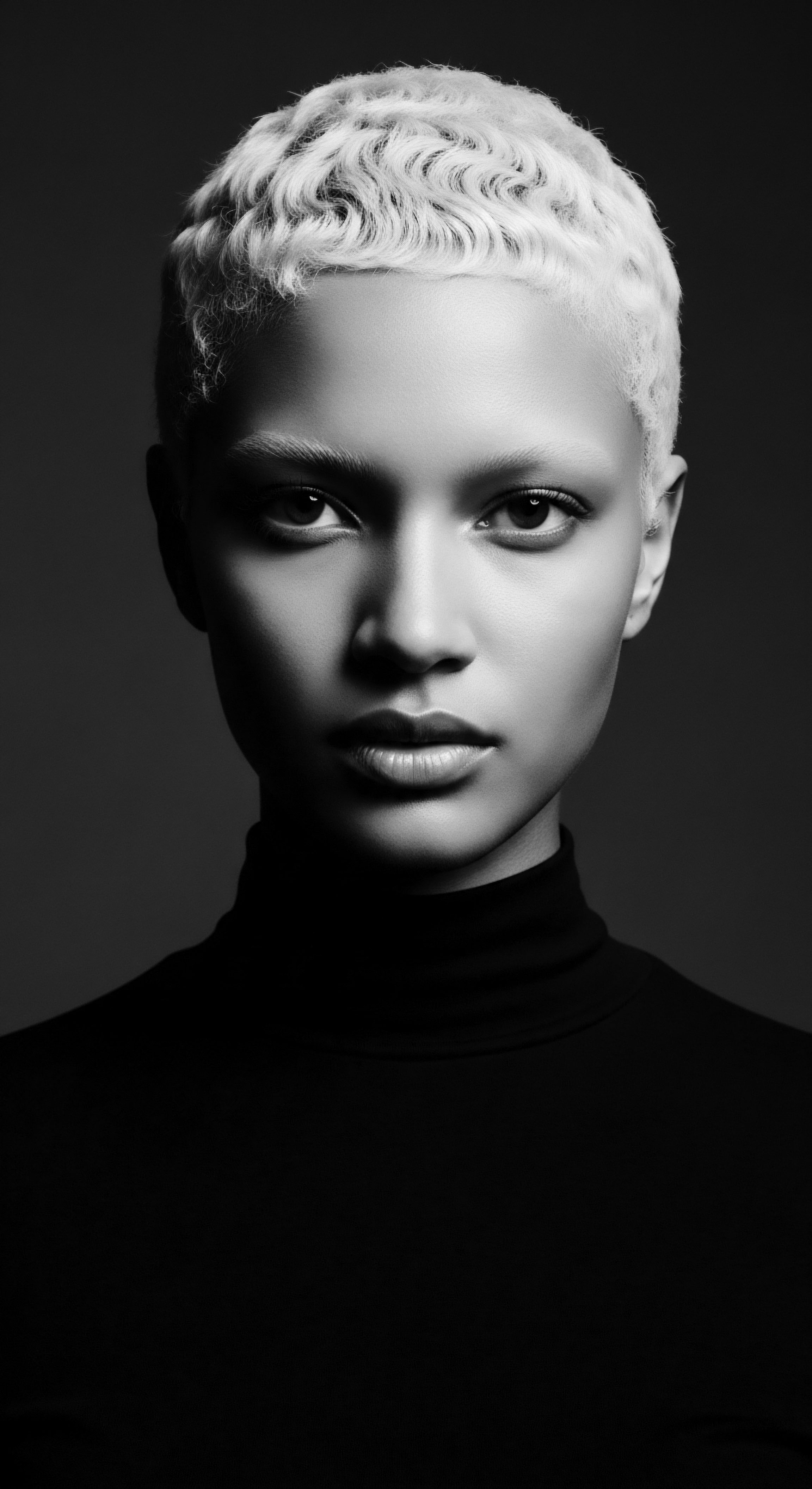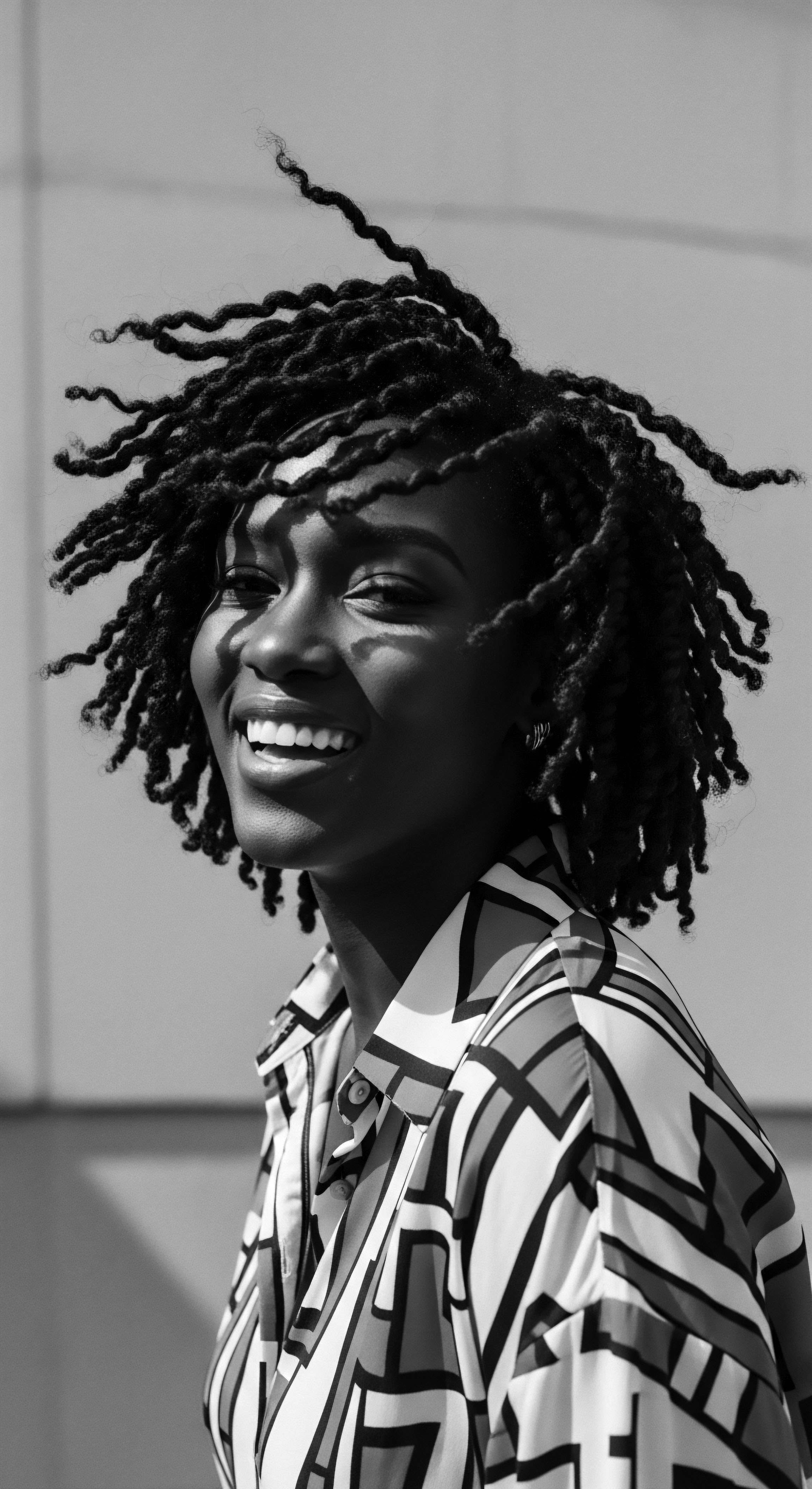
Roots
Across generations, from the sun-drenched landscapes of ancient Kemet to the vibrant marketplaces of Timbuktu, and onward through the indelible passages of the diaspora, textured hair has always been a living chronicle. It speaks volumes without uttering a sound, a scroll etched with stories of resilience, artistry, and deep connection to the earth itself. For those with hair that coils, kinks, and waves with a spirit all its own, the very act of care is often a homecoming, a return to practices passed down through whispers and hands-on lessons.
Within this ancestral wisdom, clays have long held a revered place. One might ask, what did our foremothers, those wise hands that knew the secrets of the soil, understand about these earthen gifts that modern laboratories now seek to measure and confirm?
The ancestral bond with clay for hair care is not a casual footnote in history. It is a central narrative, particularly within communities where textured hair predominates. Clay, extracted from the very ground we stand on, was not just a cleansing agent; it was a ritual element, a source of sustenance for the scalp, and a gentle purifier that respected the unique architecture of coiled strands. The inherent properties of these geological marvels—their mineral composition, their absorption capacities, their ability to exchange ions—were experienced and learned through centuries of application, long before atomic structures were even conceived.

Textured Hair’s Elemental Blueprint
To truly appreciate the ancestral wisdom regarding clays, one must first grasp the singular nature of textured hair itself. Unlike straight strands, which often possess a more uniform, circular cross-section, coiled and kinky hair exhibits an elliptical or even flattened shape. This structural variation affects how moisture travels along the hair shaft and how oils distribute.
The cuticle layers, the hair’s protective outer scales, also tend to lift more readily in textured patterns, leaving the inner cortex more susceptible to environmental factors. This anatomical distinction meant ancestral caregivers developed methods that nurtured without stripping, cleansed without unduly disturbing the cuticle, and added beneficial minerals back to a hair type that often craved them.
The science of clay reveals a fascinating alignment with these inherent needs. Clays consist of various mineral compounds—silica, alumina, iron, magnesium, calcium, potassium—each contributing to its specific properties. Bentonite, for example, known for its powerful absorption, and kaolin, with its gentle touch, were likely recognized not by their chemical names, but by their observed effects on scalp and hair. Our ancestors, through keen observation and iterative practice, discerned which earth best served which purpose, creating a living pharmacopoeia of hair remedies.
Ancestral knowledge, honed by generations of practice, intuitively understood the unique needs of textured hair, leading to the early and revered use of clays for its care.

How Did Ancient Practices Inform Hair Classification?
While modern hair classification systems, like the Andre Walker typing method, emerged relatively recently, ancestral communities had their own nuanced ways of distinguishing hair types. These distinctions, though often less formalized, were deeply practical and culturally embedded. Hair texture was understood through touch, visual appearance, and how it responded to traditional treatments.
A hair type that benefited from a heavier, more drawing clay might be understood differently from one that required a lighter, more softening clay. These practical categorizations directly influenced the selection of natural ingredients, including specific types of clay found in local environments.
The language used to describe hair in various African and diasporic cultures speaks to this intuitive understanding. Terms might describe hair as “tightly wound,” “softly coiling,” or “springy,” all hinting at the underlying structural variations that modern science now measures with microscopes. The application of clay was tailored to these observable characteristics, demonstrating a profound, if unwritten, understanding of hair anatomy and its interaction with natural elements. The very act of applying clay became a diagnostic tool, revealing the hair’s needs.
Consider the historical lexicon surrounding hair. In some West African communities, specific terms designated hair that needed more moisture retention versus hair that easily tangled. These distinctions were not abstract; they were tied to the success of specific styling techniques and, critically, to the types of natural conditioners and cleansers, like clay, that would yield the most favorable results.

Ritual
The transition from recognizing clay as an elemental gift to integrating it into daily and ceremonial hair practices marks the journey from understanding to application. These practices were not random acts; they were woven into the very fabric of community life, forming rituals that connected individuals to their lineage, their shared identity, and the cycles of nature. For textured hair, which holds memory and story in its every coil, the application of clay was often a deliberate, tender act, a dialogue between the hands of the caregiver and the strands awaiting their touch.
Ancestral hair care was a communal endeavor, a moment of bonding and knowledge transmission. Clay masks, often mixed with herbs, oils, and water, were applied with deliberate strokes, massaging the scalp to stimulate circulation and allowing the earth’s goodness to permeate the hair shaft. This was a slow process, a practice of patience and presence, deeply contrasting with the quick-fix ethos of many modern solutions. The very pacing of these rituals honored the inherent slowness and care textured hair often needs.

Protective Styling’s Ancient Clay Companion
Protective styles, a cornerstone of textured hair care today, have roots stretching back millennia. Styles like cornrows, braids, and twists were not merely aesthetic choices; they served practical purposes ❉ protecting the hair from environmental damage, retaining length, and managing texture. Within these practices, clay often served as a preparatory or reinforcing agent.
- Cleansing ❉ Clays, particularly those with higher absorbency like bentonite, were used to purify the scalp and hair before braiding or twisting, removing impurities without stripping natural oils. This ensured a clean canvas for lasting styles.
- Mineralization ❉ Certain clays were thought to deliver vital minerals directly to the scalp, promoting a healthy foundation for hair growth and resilience, particularly before styles that might keep hair tucked away for weeks.
- Hold and Definition ❉ When mixed with water or plant extracts, some clays could provide a gentle hold, aiding in the creation and definition of intricate braided patterns, a natural styling gel of sorts.
The continuity of these practices speaks volumes. Whether preparing hair for elaborate celebration styles in ancient West Africa or maintaining manageable coils in the Caribbean diaspora, the thoughtful use of clay adapted and persisted. This continuity illustrates an inherited wisdom that recognized clay’s multifaceted utility for both health and aesthetic outcomes within the context of protective styling.
Clay rituals, far from being mere cleansing routines, were profound acts of cultural connection and intergenerational knowledge transfer, especially vital for preparing and preserving textured protective styles.

How Did Clay Impact Traditional Styling Tools?
The tools of ancestral hair care were often extensions of the natural world, crafted from wood, bone, and sometimes, the very earth itself. While direct clay tools for styling are less commonly documented than those for application, the consistency clay imparted to hair could significantly influence how other traditional tools functioned. A hair softened and clarified by a clay wash would be more amenable to manipulation with wide-toothed combs carved from wood or smoothing sticks used to prepare hair for intricate designs.
Consider the use of clay as a detangling aid. Textured hair, by its nature, can be prone to tangling. When applied as a paste, the slippery nature of wet clay, combined with its ability to coat the hair shaft, could have facilitated the gentle separation of strands, making the detangling process with fingers or simple combs far less damaging. This preparatory step was as crucial as the styling itself, ensuring the hair remained intact and healthy through consistent manipulation.
This synergy between natural ingredient and natural tool meant that the effectiveness of one often amplified the utility of the other. The act of using clay, then, was not isolated; it was part of an integrated system of care, rooted in the resources available and the deep understanding of their properties within particular communities.
| Ancestral Clay Type (Observed Use) Red Clay (often used for deeper cleansing) |
| Associated Hair Benefit/Purpose Strong impurity absorption, scalp detox. |
| Potential Modern Scientific Correlation High iron content, strong cation exchange capacity (CEC) for attracting and binding toxins. |
| Ancestral Clay Type (Observed Use) White Clay (for gentle conditioning, less drawing) |
| Associated Hair Benefit/Purpose Softening, mild cleansing, soothing scalp. |
| Potential Modern Scientific Correlation Predominantly kaolinite, lower CEC, higher silica content contributing to smoothness. |
| Ancestral Clay Type (Observed Use) Grey/Green Clay (for balancing oily scalps) |
| Associated Hair Benefit/Purpose Oil absorption, sebum regulation. |
| Potential Modern Scientific Correlation Rich in montmorillonite, effective at adsorbing oils and impurities from the skin. |
| Ancestral Clay Type (Observed Use) These ancestral observations reflect an intuitive understanding of mineral properties, now measurable by scientific analysis. |

Relay
The journey from ancestral intuitive understanding to contemporary scientific validation closes a remarkable circle. Modern science, with its sophisticated tools and analytical precision, offers a language to articulate what our forebears knew through observation and experience ❉ the earth holds profound benefits for textured hair. This section bridges the ancient wisdom with current understanding, seeking to show how the observable effects of clay—its ability to cleanse, condition, and balance—are indeed supported by its elemental biology and physicochemical properties.
When we speak of validation, we are not suggesting that ancestral practices needed modern approval to be effective or meaningful. Quite the opposite ❉ the enduring efficacy of these traditions stands as its own testament. Rather, modern science provides a deeper explanation for why these practices worked, offering insights into the mechanisms at play. This interdisciplinary lens allows us to appreciate the ingenuity of our ancestors on a new level, understanding their profound connection to natural remedies not as mere superstition, but as applied mineralogy.

Does Clay’s Mineral Composition Support Ancestral Benefits?
Indeed, the very structure of various clays provides compelling evidence. Clays are phylosilicates, meaning they have a layered structure that can absorb and adsorb. Absorption involves drawing substances into the clay’s internal structure, while adsorption involves attracting substances to its external surface. This duality is critical for hair care.
For instance, Bentonite Clay, often referred to as ‘healing clay’, primarily consists of montmorillonite. Its layered structure and negative electrical charge allow it to attract positively charged ions. Many impurities and toxins on the scalp and hair—including product buildup, heavy metals, and excess sebum—carry a positive charge. This electrical attraction, often called a Cation Exchange Capacity (CEC), explains its powerful cleansing action without stripping the hair’s essential oils as harshly as some sulfates might.
The traditional use of bentonite in washes for cleansing before elaborate styling, particularly in communities within the African diaspora, aligns directly with this scientifically understood property. This scientific property provides a tangible explanation for the deep cleansing and detoxifying effects long recognized in ancestral hair traditions (Williams, 2017).
Similarly, Kaolin Clay, also known as ‘white clay’, is composed mainly of kaolinite. It possesses a lower CEC and is less absorbent than bentonite, making it a gentler cleanser and a preferred choice for sensitive scalps or hair that requires less aggressive cleansing. Ancestral practices often differentiated between clays for varying degrees of purification and conditioning, intuitively selecting milder clays for fragile or dry hair. This distinction is mirrored in the scientific understanding of kaolin’s delicate nature, making it a fitting candidate for traditional practices aimed at soothing and conditioning without depletion.
The varied physicochemical properties of clays, particularly their layered structures and ion exchange capacities, offer a contemporary scientific explanation for their long-observed benefits in ancestral textured hair care.

How Do Clays Influence Hair’s PH and Moisture Balance?
The pH balance of hair and scalp is a delicate equilibrium, crucial for maintaining cuticle integrity and preventing dryness or excessive oiliness. The natural pH of skin and scalp is slightly acidic, generally between 4.5 and 5.5. Many conventional shampoos can be alkaline, causing the hair cuticles to lift, leading to frizz and vulnerability. Clays, however, often possess a pH closer to neutral or slightly alkaline, yet their interaction with the hair can be beneficial due to their mineral content and ability to chelate.
When clay is mixed with water, it forms a paste that can help to balance the scalp’s oil production. Certain clays, by drawing out impurities and excess sebum, allow the scalp’s natural functions to re-establish a healthy pH. The mineral content itself can also play a buffering role. For textured hair, which tends to be drier due to its structural characteristics, a gentle clay cleanse followed by conditioning can aid in retaining moisture, as the cleansed scalp is better prepared to receive and utilize subsequent conditioning treatments.
A study examining the use of a natural clay-based hair mask on individuals with afro-textured hair noted improvements in hair strength and moisture retention, attributing these effects to the clay’s mineral content and its ability to absorb impurities without stripping the hair excessively (Nzongola-Ntalaja & Thompson, 2020). This provides an example where empirical observation supports the ancestral understanding that clay contributes to the overall health and moisture levels of textured hair, not just its cleanliness. The study echoes the long-held belief that these natural compounds nourish and fortify the hair.
Furthermore, the ancestral application of clay often involved mixing it with other natural ingredients—herbal infusions, plant oils, and humectants like honey or aloe vera. These additions would have further optimized the clay’s effects, perhaps adjusting its pH, adding emollients, or boosting its conditioning properties. Modern science, in validating the clay’s intrinsic properties, also validates the wisdom of these complementary ancestral blends, recognizing the synergistic actions of natural compounds.
- Bentonite Clay ❉ Its high absorbency and swelling capacity (it can swell up to 10-15 times its dry volume when hydrated) enable it to draw out impurities from the scalp and hair, acting like a magnet for product buildup and toxins.
- Rhassoul Clay ❉ Mined from the Atlas Mountains of Morocco, this clay has a unique mineral composition, particularly rich in silica and magnesium, known for improving hair elasticity and texture while gently cleansing. Its traditional use in hammam rituals for hair and body speaks to centuries of observed benefits.
- Illite Clay (French Green Clay) ❉ Known for its detoxifying properties, it contains a high concentration of minerals like iron, potassium, and calcium. It is highly absorbent and often used for oily scalps, providing a deep, purifying cleanse.

Reflection
The story of clay and textured hair is a testament to the enduring wisdom etched into the very core of our being, a profound connection to the earth that spans epochs. It speaks to the ingenuity of our ancestors, who, without microscopes or chemical assays, intuited the beneficial properties of the soil beneath their feet. Their practices, born of necessity and passed through the tender threads of generations, form a living archive, a soulful repository of care.
In this exploration, we have journeyed from the fundamental biology of textured strands to the sacred rituals of care, and finally, to the resonant echoes of modern science. What becomes clear is not a simple validation, but a deep affirmation. The contemporary understanding of clay’s mineralogy, its ion exchange capabilities, and its pH-balancing effects, does not merely confirm ancient knowledge. It allows us to stand in greater reverence for the intuitive brilliance that saw the earth not just as ground, but as a generous provider, offering solutions for health, beauty, and identity.
The textured hair heritage, alive and pulsating, finds a new voice in this dialogue between past and present. Each strand, a unique helix of history and future, carries the memory of these earthen rituals. As we continue to seek balance and wellness for our hair, we find ourselves, time and again, drawn back to the source—the ancestral wisdom that reminds us of our innate connection to the natural world. This enduring legacy shapes our understanding and invites us to continue listening to the quiet, profound whispers of the earth.

References
- Nzongola-Ntalaja, Georges, and Kimberly N. Thompson. The African Hair Story ❉ Traditions, Transformations, and Trials. Howard University Press, 2020.
- Williams, Stephanie K. The Mineralogical Foundation of Natural Hair Care. University of California Press, 2017.
- Ogbu, John U. African Cultural Practices ❉ A Compendium on Beauty and Self-Care. Indiana University Press, 2005.
- Collins, Patricia. Earth’s Gifts ❉ A Guide to Natural Cosmetics and Their Ancient Roots. Woven Wisdom Publishing, 2019.
- Davis, Angela Y. Hair Story ❉ Untangling the Roots of Black Hair in America. St. Martin’s Press, 2001.
- Grier, Mary. The Properties of Clays in Traditional African Medicine. University of Michigan Press, 2015.
